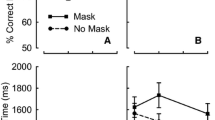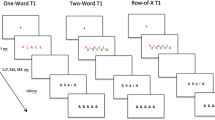Abstract
The consequences of maintaining a task set in the context of the (speeded) attentional blink were investigated in a series of experiments. Observers were asked to either attend or ignore the first of two target stimuli (T1 and T2). The results showed that when T1 and T2 shared a task relevant feature that was unique to T2, but not to T1, a shallow attentional blink was observed, as well as a lack of Lag 1 sparing. In comparison, when the targets shared a feature that was uniquely task relevant to both targets, the blink could not be avoided. Conversely, when no feature was shared between targets, ignoring T1 was successful and virtually no attentional costs were apparent. A similar lack of costs was also observed when targets shared a task relevant feature that was unique to T1 but not to T2. Finally, matching the feature dimension of a target feature that was unique to T2, but not T1, also strongly attenuated the blink. However, it did not completely abolish Lag 1 sparing. The results are interpreted in the context of current models of the attentional blink.










Similar content being viewed by others
Notes
Unconditional T2 analyses were additionally conducted, to verify whether the divergent measures of correct performance in the ignore- and attend-T1 conditions might have resulted in spurious effects on T2 performance. The analyses consistently showed highly comparable patterns, with minimal differences between unconditional and conditional means. Thus, the conditional analyses were validated with regard to this potential confound.
References
Akyürek, E. G., Eshuis, S. A. H., Nieuwenstein, M. R., Saija, J. D., Başkent, D., & Hommel, B. (2012). Temporal target integration underlies performance at Lag 1 in the attentional blink. Journal of Experimental Psychology: Human Perception and Performance (in press).
Akyürek, E. G., & Hommel, B. (2007). Stimulus and response priming in rapid serial visual presentation: evidence for a dissociation. Perception and Psychophysics, 69, 1152–1161.
Akyürek, E. G., Leszczyński, M., & Schubö, A. (2010). The temporal locus of the interaction between working memory consolidation and the attentional blink. Psychophysiology, 47, 1134–1141.
Akyürek, E. G., Toffanin, P., & Hommel, B. (2008). Adaptive control of event integration. Journal of Experimental Psychology: Human Perception and Performance, 34, 569–577.
Asplund, C. L., Todd, J. J., Snyder, A. P., Gilbert, C. M., & Marois, R. (2010a). Surprise-induced blindness: A stimulus-driven attentional limit to conscious perception. Journal of Experimental Psychology: Human Perception and Performance, 36, 1372–1381
Asplund, C. L., Todd, J. J., Snyder, A. P., & Marois, R. (2010b). A central role for the lateral prefrontal cortex in goal-directed and stimulus-driven attention. Nature Neuroscience, 13, 507–514
Bacon, W. F., & Egeth, H. E. (1994). Overriding stimulus-driven attentional capture. Perception and Psychophysics, 55, 485–496.
Barnard, P. J., Scott, S., Taylor, J., May, J., & Knightley, W. (2004). Paying attention to meaning. Psychological Science, 15, 179–186.
Bowman, H., & Wyble, B. (2007). The simultaneous type, serial token model of temporal attention and working memory. Psychological Review, 114, 38–70.
Broadbent, D. E., & Broadbent, M. H. (1987). From detection to identification: response to multiple targets in rapid serial visual presentation. Perception and Psychophysics, 42, 105–113.
Chun, M. M. (1997). Temporal binding errors are redistributed by the attentional blink. Perception and Psychophysics, 59, 1191–1199.
Chun, M. M., & Potter, M. C. (1995). A two-stage model for multiple target detection in rapid serial visual presentation. Journal of Experimental Psychology: Human Perception and Performance, 21, 109–127.
Dalton, P., & Lavie, N. (2006). Temporal attentional capture: effects of irrelevant singletons on rapid serial visual search. Psychonomic Bulletin and Review, 13, 881–885.
Di Lollo, V., Kawahara, J.-I., Ghorashi, S. M. S., & Enns, J. T. (2005). The attentional blink: resource depletion or temporary loss of control? Psychological Research, 69, 191–200.
Folk, C. L., Leber, A. B., & Egeth, H. E. (2002). Made you blink! Contingent attentional capture produces a spatial blink. Perception and Psychophysics, 64, 741–753.
Folk, C. L., Leber, A. B., & Egeth, H. E. (2008). Top-down control settings and the attentional blink: evidence for non-spatial attentional capture. Visual Cognition, 16, 616–642.
Folk, C. L., & Remington, R. W. (1998). Selectivity in distraction by irrelevant featural singletons: evidence for two forms of attentional capture. Journal of Experimental Psychology: Human Perception and Performance, 24, 847–858.
Folk, C. L., Remington, R. W., & Johnston, J. C. (1992). Involuntary covert orienting is contingent on attentional control settings. Journal of Experimental Psychology: Human Perception and Performance, 18, 1030–1044.
Folk, C. L., Remington, R. W., & Wright, J. H. (1994). The structure of attentional control: contingent attentional capture by apparent motion, abrupt onset and colour. Journal of Experimental Psychology: Human Perception and Performance, 20, 317–329.
Hommel, B., & Akyürek, E. G. (2005). Lag 1 sparing in the attentional blink: benefits and costs of integrating two events into a single episode. Quarterly Journal of Experimental Psychology, 58A, 1415–1433.
Jolicœur, P. (1999). Concurrent response-selection demands modulate the attentional blink. Journal of Experimental Psychology: Human Perception and Performance, 25, 1097–1113.
Jolicœur, P., & Dell’Acqua, R. (1998). The demonstration of short-term consolidation. Cognitive Psychology, 36, 138–202.
Jolicœur, P., Sessa, P., Dell’Acqua, R., & Robitaille, N. (2006). On the control of visual spatial attention: evidence from human electrophysiology. Psychological Research, 70, 414–424.
Joseph, J. S., Chun, M. M., & Nakayama, K. (1997). Attentional requirements in a ‘preattentive’ feature search task. Nature, 387, 805–807.
Maki, W. S., & Mebane, M. W. (2006). Attentional capture triggers an attentional blink. Psychonomic Bulletin and Review, 13, 125–131.
McLaughlin, E. N., Shore, D. I., & Klein, R. M. (2001). The attentional blink is immune to masking-induced data limits. Quarterly Journal of Experimental Psychology, 54A, 169–196.
Olivers, C. N. L., & Meeter, M. (2008). A boost and bounce theory of temporal attention. Psychological Review, 115, 836–863.
Olivers, C. N. L., & Nieuwenhuis, S. (2006). The beneficial effects of task load, positive affect, and instruction on the attentional blink. Journal of Experimental Psychology: Human Perception and Performance, 32, 364–379.
Ouimet, C., & Jolicœur, P. (2007). Beyond Task 1 difficulty: the duration of T1 encoding modulates the attentional blink. Visual Cognition, 15, 290–304.
Potter, M. C., Staub, A., & O’Connor, D. H. (2002). The time course of competition for attention: attention is initially labile. Journal of Experimental Psychology: Human Perception and Performance, 28, 1149–1162.
Raymond, J. E., Shapiro, K. L., & Arnell, K. M. (1992). Temporary suppression of visual processing in an RSVP task: an attentional blink? Journal of Experimental Psychology: Human Perception and Performance, 18, 849–860.
Seiffert, A. E., & Di Lollo, V. (1997). Low-level masking in the attentional blink. Journal of Experimental Psychology: Human Perception and Performance, 23, 1061–1073.
Sergent, C., Baillet, S., & Dehaene, S. (2005). Timing of the brain events underlying consciousness during the attentional blink. Nature Neuroscience, 8, 1391–1400.
Shapiro, K. L., Driver, J., Ward, R., & Sorensen, R. E. (1997). Priming from the attentional blink: a failure to extract tokens but not visual types. Psychological Science, 8, 95–100.
Spalek, T. M., Falcon, L. J., & Di Lollo, V. (2006). Attentional blink and attentional capture: endogenous versus exogenous control over paying attention to two important events in close succession. Perception and Psychophysics, 68, 674–684.
Theeuwes, J. (1991). Cross-dimensional perceptual selectivity. Perception and Psychophysics, 50, 184–193.
Theeuwes, J. (1992). Perceptual selectivity for color and form. Perception and Psychophysics, 51, 599–606.
Theeuwes, J. (1994). Stimulus-driven capture and attentional set: selective search for color and visual abrupt onsets. Journal of Experimental Psychology: Human Perception and Performance, 20, 799–806.
Theeuwes, J., & Burger, R. (1998). Attentional control during visual search: the effect of irrelevant singletons. Journal of Experimental Psychology: Human Perception and Performance, 24, 1342–1353.
Treisman, A. M., & Gelade, G. (1980). A feature-integration theory of attention. Cognitive Psychology, 12, 97–136.
Visser, T. A. W. (2007). Masking T1 difficulty: processing time and the attentional blink. Journal of Experimental Psychology: Human Perception and Performance, 33, 285–297.
Visser, T. A. W., Bischof, W. F., & Di Lollo, V. (1999). Attentional switching in spatial and non-spatial domains: evidence from the attentional blink. Psychological Bulletin, 125, 458–469.
Vogel, E. K., Luck, S. J., & Shapiro, K. L. (1998). Electrophysiological evidence for a postperceptual locus of suppression during the attentional blink. Journal of Experimental Psychology: Human Perception and Performance, 24, 1656–1674.
Ward, R., Duncan, J., & Shapiro, K. L. (1996). The slow time-course of visual attention. Cognitive Psychology, 30, 79–109.
Ward, R., Duncan, J., & Shapiro, K. L. (1997). Effects of similarity, difficulty, and nontarget presentation on the time course of visual attention. Perception and Psychophysics, 59, 593–600.
Wee, S., & Chua, F. K. (2004). Capturing attention when attention “blinks”. Journal of Experimental Psychology: Human Perception and Performance, 30, 598–612.
Wolfe, J. M. (1998). Visual search. In H. Pashler (Ed.), Attention (pp. 13–73). Hove: Psychology Press.
Wyble, B., Bowman, H., & Nieuwenstein, M. (2009). The attentional blink provides episodic distinctiveness: sparing at a cost. Journal of Experimental Psychology: Human Perception and Performance, 35, 787–807.
Acknowledgments
This research was supported by the German Research Foundation (DFG) as part of the excellence cluster “Cognition for Technical Systems” (CoTeSys), project #148.
Author information
Authors and Affiliations
Corresponding author
Rights and permissions
About this article
Cite this article
Akyürek, E.G., Köhne, C. & Schubö, A. Task set flexibility and feature specificity modulate the limits of temporal attention. Psychological Research 77, 583–598 (2013). https://doi.org/10.1007/s00426-012-0447-7
Received:
Accepted:
Published:
Issue Date:
DOI: https://doi.org/10.1007/s00426-012-0447-7




